
Editor’s Note: As a journalist specializing in archaeology, I am not usually inclined to travel on group tours. The fact, however, remains that tourism is actually an essential player when it comes to the impact and benefits that archaeological excavations and research have bestowed on world economies, particularly countries that possess an enormously rich and often spectacular heritage of humanity’s past. Andante Travels, a British tour company that specializes in archaeological and cultural tours, has in this writer’s opinion pulled together perhaps the most compelling opportunities for travelers when it comes to experiencing our global archaeological and cultural heritage from the educated ‘layman’s’ perspective. Originally created by archaeologists themselves for lovers of archaeology, it affords travel experiences that cater primarily to individuals with distinctive academic and cultural interests. What follows is my personal venture with one of those offerings—one I felt uncharacteristically compelled to experience on my own:
_________________________________________
Naples, Italy — Although November is considered the wettest month in this, the third largest city of Italy, my arrival was graced by the sun. Traveling by motor coach with like-minded friends from the international airport, one could easily see why, even in the latter half of autumn, this city and its environs still make for a very holiday-like visit. Trees, still green, some bearing yellow-orange citrus, and the distinctive stone pine and umbrella trees that famously define the landscape of the Naples region, accent the view along the main freeway leading southeast from the city. Here there are scenes I’m not accustomed to seeing while on the road in most places of my home country, the U.S. In Naples, apartment complexes and houses are colorfully painted and even household laundry, hanging from balcony lines and rippling in the breeze that flows in from the nearby Bay of Naples, adds some color and interest — a reminder that people like all of us live here.
Situated only a few miles from Salerno in the region of Campania, the little city of Cava de’ Tirreni strikes a picturesque pose within a valley rich in agricultural land, surrounded by wooded hills. It is on one of these hills where I found myself settled into Hotel Scapolatiello, a family-owned and operated business established in 1821, located within walking distance of a thousand-year-old Benedictine Abbey and nestled with breathtaking views in its context of surrounding hills and the valley below. My initial impression, and perhaps the best part of the stay here: My room, which featured shutters that could be opened up to the fresh air and a lofty view of the hills and valley landscape below me. I could stand there for hours, and the temperature, albeit mid-November, was comfortably cool, with a breeze carrying the scents of the local flora, still mostly green in defiance of autumn. This first night, only a few hours away from arrival, featured a lecture from our accompanying Guide Lecturer, John Shepherd, relating a comprehensive review of the history and geology of the Bay of Naples area and Campania, anticipating our upcoming visits to the ancient sites — some iconic, such as Pompeii and Herculaneum, and some less so but equally compelling.
______________________________________

Above and below: The Hotel Scapolatiello.
______________________________________

______________________________________

Opening the shutters: The view from my hotel room window. (Yes, that is a rainbow in the distance). A slight, slow rocking earth tremor came calling early one morning before breakfast, reminding us that the geology of the region is still very active.
______________________________________
The Roman Villa of Positano
The Amalfi coast, named after the town of Amalfi on the Sorento Peninsula, is famously known for its majestically scenic beauty. Nick-named the “Divine Coast” and historically a popular destination for Europe’s jet set, it is no wonder that it is among the most visited regions of Italy, particularly during the high tourist season between April and October. Rugged, rocky vertical lines and cliffs, dressed by nature’s artful touch of green pine and other flora, overlook the vast, glistening blue water of the Mediterranean. To negotiate it, one must drive the winding and relatively narrow 25-mile-long Amalfi Drive that hugs the steep coastline from the town of Vietri sul Mare in the east to Positano in the west. For this writer, the drive was a bit like being in a visual heaven, but, like my discriminating colleagues, this was all secondary to our objective — the Roman Villa of Positano.
Otium
“Otium,” is a latin term which in ancient Roman times meant ‘leisure time’, a luxury of the Roman elite, who had their sumptuous seaside villas built along what is presently the Amalfi coast beginning as early as the Julio-Claudian Dynasty (27 BC to 68 AD). This was where the rich and famous played, away from the usual business of Rome and other urban centers. Evidence for one of these otium villas, today called the Roman Villa of Positano, was first discovered by Karl Weber, the initial excavator of Pompeii and Herculaneum, in 1758. But the most extensive excavations were undertaken between 2003 and 2016, when archaeologists uncovered a startlingly well-preserved portion of the villa beneath the medieval hypogeum of the Santa Maria Assunta church at the city center. Although it represented but a fraction of the original structure, the room, determined by the archaeologists to be a triclinium, featured walls covered with masterfully rendered fine fresco painting in brilliant color and clarity, almost as if they had been painted yesterday. “Yesterday”, in this instance was a time not long after 62 AD, when an earthquake’s destruction presented the opportunity for the villa’s ownership to renovate, including this triclinium now on view to the public. Scholars have suggested that the villa may have been owned by Posides Claudi Caesaris, a wealthy and powerful man who, once a slave or servant, had been favored and freed by Emperor Claudius himself. It is thought that Positano may have taken its name from this individual. What can be seen today of Posides’s grand villa is its appearance just moments before it was buried beneath the same ash, pumice, and pyrooclastic flows that destroyed Pompeii and Herculaneum in 79 AD. Archaeologists and scholars suggest that the greater complex featured at least a peristyle with a central garden and fountain, along with the triclinium and bath quarters — features typical of a Roman villa of the times.
Unlike Pompeii, Herculaneum, and other sites such as Stabiae, the Roman Villa of Positano afforded us the opportunity to see something “off the radar” for many visitors who come to see the most iconic spots in Campania. It is an example of the special and distinctive itineraries developed by Andante Travels for their guests.
______________________________________

The rugged and beautiful Amalfi coastline.
______________________________________

Above and below: Views of the wall painting in the Villa of Positano. The two lower photos show painting features displacement caused by the ancient earthquake.
______________________________________

______________________________________

______________________________________
Pompeii
Archaeologically speaking, Pompeii is arguably the world’s most spectacular archaeological site and park. Home to about 11,000 to 11,500 people in its day, the city’s urban footprint spreads across 160 to 170 acres, and archaeological excavations have thus far uncovered about two thirds of the city. Although excavations continue, efforts now focus on specific, smaller areas with designs to achieve certain research objectives. Conservation of current exposed remains also continues to be a major priority of governing authorities for the site.
Thus it was no wonder that, given the site’s massive size and complexity, along with the sensational state of preservation reflecting everyday living in the ancient Roman Empire, our group was allotted a full day to explore its remains — not typical of the usual group ‘day’ tours that afford but two or three hours. John Shepherd, our Guide Lecturer, began leading us just outside the city walls by addressing the common thread underpinning our entire exploration of the Bay of Naples area — the eruption of Mt. Vesuvius in 79 AD. and the massive destruction, yet concomitant preservation, that followed in its wake. We proceeded afterwards to walk the ancient city streets and through some of the most prominent and spectacular structures and features of the city, including the remarkably well preserved amphitheater. Throughout, Shepherd detailed the stories and research findings behind every stop, giving us an inside, intimate perspective that could not possibly be acquired by exploring on one’s own.
A highlight of this tour was the time spent at the recent discoveries in Regio V, where archaeologists uncovered, among other things, a well-preserved thermopolium, a cook-shop or snack bar conceptually much like a fast-food shop one would encounter today in the modern world. I imagined the city residents wandering by during its day, some stepping in to purchase a freshly cooked snack or meal, just as one might enter a modern Chipotle or Panera establishment just off the road today. This shop, in contrast to other similar shops we had already observed as we walked along the streets, featured unusually rich painting illustrations, such as a Nereid on horseback in a marine environment, still life scenes and representations of animals likely slaughtered, the meat of which was prepared and sold to customers in the shop.
It is not enough to see pictures and read about Pompeii in the popular literature. The massive site demands a personal encounter with sufficient time to properly absorb it, and Andante fulfills this exceptionally well.
_________________________________________

The recently discovered thermopolium.
_________________________________________

Above and below: Views of Pompeii.
_________________________________________

_________________________________________

_________________________________________
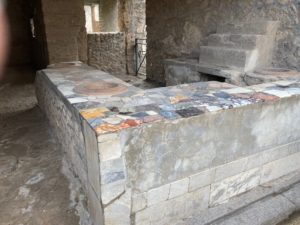
_________________________________________

_________________________________________

_________________________________________

_________________________________________
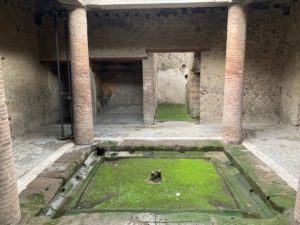
_________________________________________

Even as Pompeii hosts its many visiting tourists, archaeological conservation and excavation work continues in the ancient city. These workers were oblivious to our presence as we passed them along the ancient street.
_________________________________________
Herculaneum
One cannot speak of Pompeii in the context of the 79 AD Vesuvius eruption without speaking of Herculaneum. Like Pompeii anciently, it bore the brunt of the cataclysm. We arrived at Herculaneum in the morning, embarking on a half-day’s worth of exploring the site. Given the size of the site compared to Pompeii, the stay was proportional, but experiencing the remains here was every bit as spectacular, if not more. An obvious difference between Pompeii and Herculaneum can be seen in the generally well-preserved height of the structures, as well as much of the restored decor within the structures. If one wants to see architecture and art more akin to the way it actually appeared before the eruption, Herculaneum earns first place. Here again, Shepherd related in detail the facts and stories behind the incredibly well-preserved structures and their decorative elements, affording his guests a rich tapestry of the physical appearance and lives of the citizenry, an experience not enjoyed by most visitors. Additionally, we were provided with ample time at the end of Shepherd’s program to explore Herculaneum on our own, a luxury made possible in part because, in comparison to Pompeii, the smaller area combined with instruction minimized the probability that individuals would get themselves lost!
Important to keep in mind for the future, the Park authorities are contemplating plans to excavate the still un-excavated forum area of the site, which may be open to public observation during the excavations.
_______________________________________

Above and below: Views of Herculaneum.
_______________________________________

_______________________________________

_______________________________________

_______________________________________
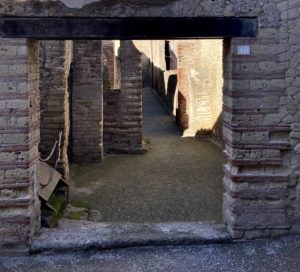
_______________________________________

_______________________________________

_______________________________________

Note the carbonized wooden beam exposed in this structure along Herculaneum’s decumanus maximus (central main street).
_______________________________________

_______________________________________

_______________________________________

_______________________________________

This marks the ancient shoreline at Herculaneum during the time of the Vesuvius eruption.
_______________________________________

One example of the skeletal remains discovered at Herculaneum, preserving the final moment of life during the eruption.
_______________________________________
Baia
Be wealthy, and visit any of today’s most luxurious, seaside spa resorts designed for relaxation and fun in the sun, and you would get a modern-day taste of what defined the ancient site of Baia in its 1st Century A.D. heyday, nestled on the shore of the Gulf of Pozzuoli (part of the Gulf of Naples). This was a destination of choice for ancient Rome’s rich and famous. For centuries, Roman emperors and the Roman elite established opulent getaway villas here. While it drew people for the healing powers of its mineral springs and the soothing fragrance of the surrounding myrtle groves, it also became known for the hedonistic lifestyle of its residents, both permanent and transient. Its spas and baths drew everyone who was anyone, and stories of corruption and scandal is said to have marked its character, whether true or false. Only a fraction of its sumptuous massive architecture has been exposed. Its remains cascade down the steep rocky slopes that overlook the gulf. The numerous baths and complexes that functioned in their time were fed by the natural hot springs as well as fresh water transported in by the nearby Augustan aquaduct. Unlike the better known iconic sites of nearby Pompeii and Herculaneum, it is not on everyone’s must-see bucket list. But the fact remains that what any visitor can see here is every bit as impressive and engaging. Our exploration took us through most of the site, and, like Herculaneum, in addition to Shepherd’s insightful guidance and detailed lecture, we were permitted free time to independently explore its corners on our own. One could get lost here, meant of course in a good way.
________________________________________
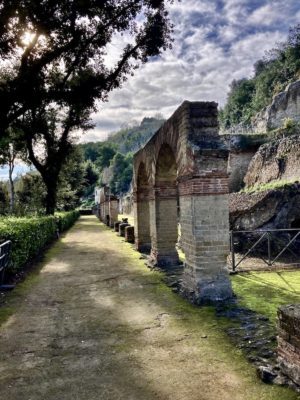
Above and below: Views of Baia.
________________________________________

________________________________________

________________________________________
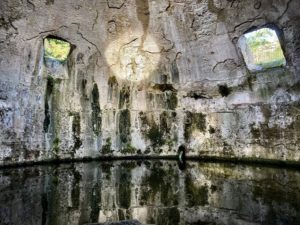
________________________________________

________________________________________

________________________________________

________________________________________

________________________________________
Pozzuoli
Imagine yourself as a member of the Roman Senate vacationing at your summer villa at Baia and you have plans for some exciting entertainment. Gladiatorial combat is a favorite of yours, so you have your horses harnessed to get yourself and your guests off to the games at the nearby Flavian amphitheater in Puteoli (today known as Pozzuoli).
One of the grandest amphitheaters of ancient Rome, the Flavian amphitheater of Pozzuoli is considered the third largest after the Colosseum in Rome and the Amphitheater of Capua. With a historic capacity of 50,000 spectators, it measures 482 x 384 feet, with the arena floor alone at 237 x 139 feet. We were impressed first by the exterior remains towering above us, reddish brickwork providing a contrast with other grey-hued structural elements. On this day, we were not permitted to enter the arena. A fire occurred not long before and authorities had the arena cordoned off while investigations were being conducted. Our disappointment quickly disappeared, however, when we stepped down into its subterranean spaces. Like a world unto itself, a massive system of arches, chambers, walls and fallen pillars lay before us, left as if the ancient inhabitants had just abandoned the spaces only the day before. It was difficult to believe the almost pristine freshness of the stone and brickwork. Hidden, protected from the ravages of human activity and weathering above ground level over the centuries, it seemed, like Pompeii and Herculaneum, frozen in time. One could still easily imagine the sight and sounds of the sets, animals, and other equipment and devices in play within the cool spaces, now mostly empty, as workers made preparations for the pending performance. In my mind’s ear, a somewhat muted ancient roar of the sitting crowds above could be heard. Here, too, following Shepherd’s guidance and detailed lecture, we were permitted free time to independently explore these internal spaces on our own.
____________________________________

Above and below: Views of the amphitheater at Pozzuoli.
____________________________________
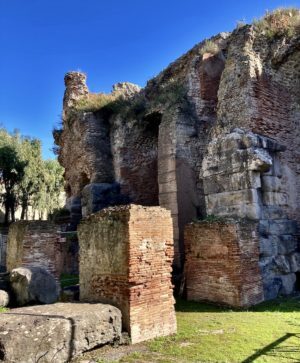
____________________________________

____________________________________

____________________________________

____________________________________

____________________________________
Villa Augustea
Our last day was highlighted by visits to the remains of two ancient Roman villas. What made these visits special was the fact that we were permitted private access to the sites, a privilege not routinely granted on typical tours of ancient Italy. Our first stop was a seaside villa known as the Villa Sora (Torre del Greco). Affording a remarkably intimate view of the adjacent bay, we walked through the results of excavations that still showed the outward signs that this was an ongoing work in progress with clearly much more work to do. What was visible to us this day, however, was proof enough that this was a sprawling estate, hugging the sea yet clearly, given the evidence and known history of its context, a large agricultural operation. A walkable carpet of grass framed architectural remains that protruded above ground, showing the promise of much more to be discovered beneath. But the highlight of the experience was the more deeply defined excavated area that revealed the architectural details of the villa’s interior spaces — frescoed walls, steps, floors — that clearly marked an unfinished business for the laboring teams, now absent during our group’s sojourn here, begging for more excavation beyond the trench’s current perimeter.
But the most surprising, breathtaking experience came after we made our way later that day to the second major site of the day, located near Somma Vesuviana, a town on the north side of Vesuvius. Unlike other archaeological sites in the area like Pompeii and Herculaneum, this was a rural setting. We approached the location by walking past a fenced-off agricultural field toward a stationary construction crane in the distance, towering conspicuously above a flat, green landscape.
Our first-blush experience upon arrival was much like looking down into an open-pit mine — though much more aesthetically pleasing. We were peering down on the results of recent and ongoing excavations of a spectacularly massive ancient Roman villa — massive and jaw-dropping not only in size but also in its remarkable state of preservation. Descending down via a stairway constructed for workers and visitors, we saw, up close and personal, walls, pillars, floors, doorways, and other architectural features, frozen in time, entombed in large measure as they were before they were overwhelmed and smothered by the ash, pumice, pyroclastic fall, surge and flow activity of a Vesuvius eruption. This was not the exclusive work of the eruption of 79 AD. It was the legacy of multiple eruptions, but most especially that of the eruption of 472 AD. Recent excavations had cut laboriously through the cataclysmic coat that had been deposited over and through the villa, such that we could see the vertical profile of the stratigraphy of volcanic deposits in distinct layers, left as a physical record by the excavators to mark the phases of the eruption that impacted the site.
Less known in the popular literature than the famous 79 AD eruption that assaulted Pompeii and Herculaneum, the 472 AD event, otherwise known as the Pollena eruption, impacted multiple relatively prosperous communities that thrived near the time of the decline of the Roman Empire. One of these included the sprawling, elaborate Villa Augustea, or Villa of Augustus, named after Augustus as it is thought that it could have a connection (under scholarly debate) to Emperor Augustus, who died at the nearby ancient town of Nola in 14 AD. The site was initially discovered in the 1930’s with limited excavation, but the most extensive investigation began in 2002 through a multidisciplinary project with the University of Tokyo. Those excavations have revealed walls preserved to a remarkable height, doorways decorated with Dionysiac motifs, a pilastered arcade, apses decorated with frescoes, cisterns, terraces, colonnades, and a large wine cellar with dolia (large earthenware jars), some of which can be seen still buried to their lips in the ground. Scholars have determined that they still contained fermenting grape juice when the eruption occurred. For a time, this was clearly more than a wealthy person’s villa — it was also a production facility for wine, the principal product of the region. Many artifacts, including a marble statue of Dionysus, the god of wine himself, were also recovered in the process.
It was a fitting end to an astounding exploration of ancient sites around the Bay of Naples—arguably the richest, by square mile, archaeological landscape in the world.
______________________________________

Above and below: Views of the Villa Sora (Torre del Greco).
______________________________________

______________________________________

______________________________________

______________________________________

Above and below: Views of Villa Augustea.
______________________________________

______________________________________

______________________________________

______________________________________

______________________________________

______________________________________
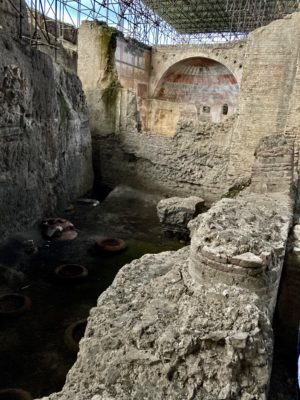
______________________________________
Museums
Any archaeologically-oriented tour would not be complete without including visits to key museums. This is where one can see, close-at-hand, some of the most important and/or most spectacular or diagnostic individual artifacts unearthed at the sites explored. In our case, there were museums attached to or related to most of the sites encountered during our visits, perhaps the most iconic of which was the famous National Archaeological Museum in Naples. Here, for example, the curators have displayed some of the most magnificent fresco paintings and other works of art and artifacts of Pompeii, among other sites. Here they are kept safe, preserved from the deleterious effects of the exterior environment, and close-at-hand for further study and conservation — and, of course, as a convenient one-stop destination for the public to see some of the most impressive objects representing the archaeology and ancient culture of the region.
For this author, the museum that left the most positive impression was unequivocally the facility attached to the site of Herculaneum. Small in comparison to the National Archaeological Museum of Naples, it is nonetheless rich with some of the finest artifacts and art pieces archaeologists have unearthed since the inception of investigations at the site. Furniture, tableware, jewelry, fresco paintings — all of the items that tell the story of Roman life in this coastal city for both the rich and the not-quite-so-rich, including a remarkably well-preserved boat recovered from the deposits that defined the ancient Herculaneum coastline when Vesuvius made its disastrous assault — make this museum something not to miss on any itinerary that includes Herculaneum.
______________________________

Above and below: Artifacts recovered from the Herculaneum excavations, as exhibited in the associated museum. Shown above is a well-preserved boat.
_______________________________________

_______________________________

_______________________________

_______________________________

_______________________________

_______________________________
This writer should mention that, as would be the case with any international journey, the shifting circumstances of the COVID pandemic can and does have an impact on plans. So it was also with Romans on the Bay of Naples. One prime objective of the tour was to visit the remains of Villa Jovis, the grand get-away villa of Emperor Tiberius on the island of Capri, not far off the coastline of Naples. Pandemic impacts unfortunately affected the resources that could be made available for our group visit at the site, and thus this opportunity had to be cancelled. Nonetheless, adjustments were made such that a meaningful and very memorable visit to this island destination could be realized, which included a stunning boat exploration of the various grottos and scenic points around the picturesque island.
Finally, one can argue that visiting archaeological sites on one’s own, or with one or two friends or family members, can have advantages of flexibility and affordability that a group tour cannot bestow. However, aside from the education, insight, and value that an expert-led group visit can offer, few experiences can match the opportunity a group tour with like-minded travelers can offer when it comes to the adventure of meeting fellow travelers who, each and every one, are a treasure house of life’s experiences and stories that are, in a different way, as fascinating and interesting as the sites one is visiting. This writer made some meaningful new friends along the way.
*All photographic images were taken by the author on the November tour, taking advantage of the much lower numbers of tourists during the region’s ‘off-season’ for tourism.
Find out more about the Andante Travel experience generally by visiting their website.
_______________________________________
About The Tour Leaders
One of the elements that make specialized tours like those of Andante valuable, of course, is the skilled and knowledgeable accompaniment of archaeologist/scholars who are deeply informed and experienced about the destinations of the travel itinerary. Beyond simply having the remarkable visual experience of the sites, guests are afforded an ongoing narrative of facts, history, stories and detailed observations that only an expert can impart. This bestows immeasurably more meaning and appreciation for the structures, objects, and landscapes the visitor is experiencing. Add to this the advantage of having a tour manager along to ensure the smooth and secure operation of your visit and to facilitate meeting your every need and convenience, and one can see why group tours like those of Andante are well worth the value they offer………..
Getting the Inside Story from John Shepherd

More valuable than any element of our tour, we were imbued with a sense of personal connection to the people who lived and, in some cases, tragically died so long ago in the places we visited. This could not have happened without the detailed insight that John Shepherd so brilliantly imparted to us as we sojourned among the remarkably well-preserved remains of the towns and villas we visited.
I asked Shepherd about what he regarded to be his favorite site and what he enjoyed the most about being a guide lecturer. Hands down, his favorite site activity revolved around leading groups through Pompeii:
“I came to realize that an important part of the study of archaeology was the dissemination of the stories that we can weave from all the evidence,” said Shepherd, who is an archaeologist, “and so there are many stories based upon the same evidence, depending upon your viewpoint in a particular place or part of society in antiquity. Even at a very early age I was, precociously, a relativist – never really believing in a single true story about the past but the intricate tapestry upon which one can set ones gaze and see different things.”
“When you get to a place like Pompeii,” Shepherd continued, “well, there it is — the perfect frame on which to weave that tapestry. Wherever I go around that town, taking guests, every room in every house affords a chance to tell a story about who lived there — their ‘trials and tribulations’, their loves and hates. Pompeii provides the opportunity to consider what its inhabitants were thinking, what they aspired to – how poor, how rich, how kind, how cruel, how enlightened, how traditional. All of these things we might see in ourselves, and although it was most definitely a different place and time – and they did hold differing attitudes about so many things compared to us (technology, etc., aside) I do hope that my group guidance helps to populate the town with many characters – such as we find in our own towns. But most importantly, I hope to leave visitors with the idea that, armed with a little knowledge about a few various aspects of Roman life, then as they move around the town it begins to become familiar to them — how a street worked, how a house was laid out, who used what parts, whether we were in a smart place or a rundown area.”
“So there it is,” he concludes. “Making the lives of those people who called Pompeii their home accessible through storytelling to modern visitors and leaving the visitors with a feeling of understanding of what the town meant to those Pompeiians – that, I suppose, is my manifesto.”
Shepherd specializes in ancient glass, and he has worked across Europe as an archaeologist, including the UK, Italy, France, and Bulgaria. He worked at the Museum of London for over 20 years, and published Professor W F Grimes’s post war excavations on the London Temple of Mithras and the Cripplegate Roman Fort. He also established the Museum’s Archaeological Archive and Research Center. After leaving the Museum in 2004, he focused on developing the use of museum archaeological collections in universities and schools. Since 2019 he has been working with Pre-Construct Archaeology to publish their Iron Age and Roman sites. And lastly but no less significant, he designed and led the London Borough of Islington’s World War 1 commemorative projects, including ‘The Streets They left Behind’ – which located every man (and a few women) with Islington connections who died in World War I, identifying as many as possible of their last known Islington addresses before the soldiers went off to war and never returned.
Going First Class with Anna

“I like working with people,” says Anna Vigetti, the tour manager who traveled with us on this tour. “My biggest satisfaction is seeing that our guests are happy. That’s the reason I’m here: to give them the best experience possible.”
Based on my first-hand experience watching her work and play with us on this journey, there is no exaggeration in her statements. Every step of the way, we were treated like VIPs, allowing us to throw every personal, logistical and safety concern out the window of our minds. She ensured that every person in the group was accounted for before the group was transported on to the next destination, and that the travel plans and mechanics were executed as effectively as possible, including meals, accommodations, transport, site access, and much more. It afforded us the luxury of focusing entirely on the up-close-and-personal educational and visual experience of the sites, countryside and museums we traversed. She even pampered us with little things along the way, like offering and distributing treats as we traveled.
Anna’s specialized talents had already been honed by years of experience as a tour manager. Born in Italy to a Scottish mother and Italian father, she eventually went on to acquire her undergraduate degree at the University of Edinburgh in Scotland, then her graduate degree in Cultural Heritage Management from the University of Barcelona in Spain. She has a native fluency in Italian and English (which came in handy when she functioned as our interpreter at certain sites during the tour), a full professional proficiency in Spanish and Catalan, and a working proficiency in French. She began work with Andante Travels in 2014, leading groups as a tour manager at such locations as the Campania region of Italy (which includes Pompeii, Herculaneum, and many other archaeological sites), Spain, Peru, Chile, Bolivia, Oman, and Easter Island, among others. Managing tours, however, is only one element in the spectrum of her skill sets, which includes translation, an activity in which she found herself more profusely engaged during the pandemic. She currently lives in Barcelona, Spain.
I asked her about some of her favorite experiences while working as a tour manager. Her response was enough to inspire anyone to want to travel:
“On one of my first tours around Naples,” she began, “I was blown away by a carbonized loaf of bread from Roman times that looked like it had just come out of the oven;
On Easter Island, I couldn’t stop thinking about what it must have been like for the Rapa Nui to live on such a tiny patch of land 3,500 km away from the nearest continent. It’s a very strange feeling to be so far away from everything. Their world was so small and so different from ours!
In northern Spain, it was incredibly moving to catch a glimpse of deer running across the hillside and, minutes later, stand in a small cave (the Covalanas cave) looking at beautiful images of deer painted by our ancestors during the Paleolithic Age.
And another incredible experience included visiting the Masaya volcano in Nicaragua at night. It glowed in the dark and you could see it from miles away. When we got to the top, we saw lava flowing and splashing inside the crater, and even heard the lava waves – it was like listening to the sea. Just mind-blowing!
Many of these moments feel like actual time travel, because they give me a deep sense of connection with people who lived hundreds or thousands of years ago. Others have something to do with experiencing the force and beauty of nature in different ways. And then apart from that, of course — every time I go somewhere new I get a wonderful sense of adventure and discovery.”
More information about Andante Travels can be obtained online at their website.
___________________________________________
Advertisement


